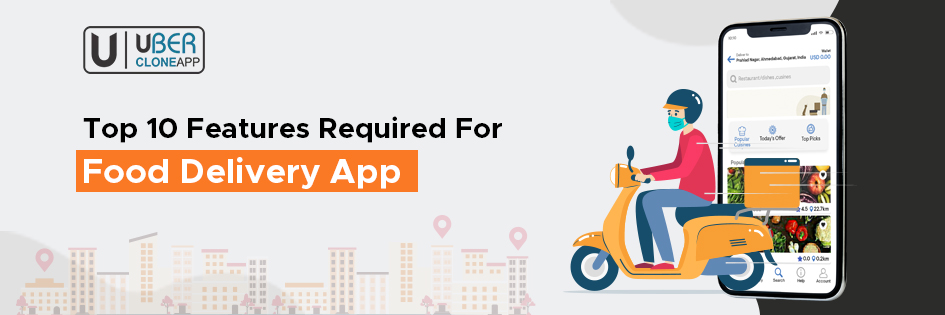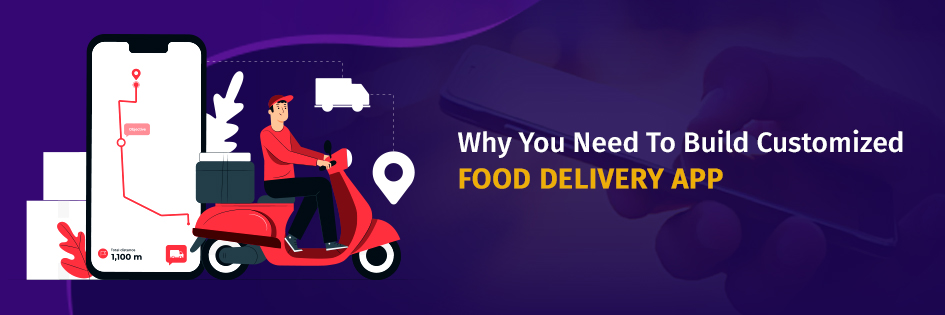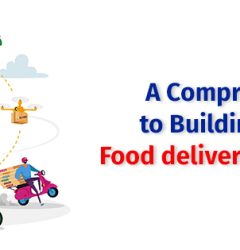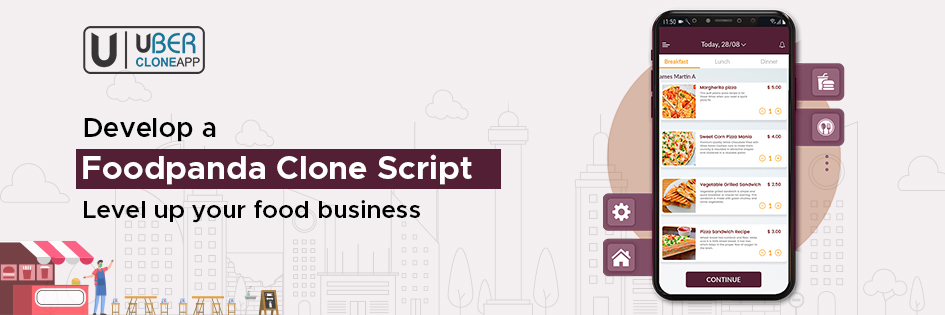
No wonder people crave delicious food, but honestly, they are not always in the mood to go out to restaurants. Here, food delivery apps come to a rescue. They tend to make life easier by delivering mouthwatering meals to your doorstep – With just a few clicks.
Not just foodies, but launching an app is also a lucrative business opportunity for restaurant owners. They can buy the best Online Food Delivery script and get their feature-loaded app ready to deliver happiness all around. Scripts are pre-built software solutions that have gained massive popularity among entrepreneurs aiming to tap into the food delivery market swiftly and effectively.
Want to know more about the food delivery app script and the top 10 features required to create such scripts? Let’s explore this article that comprises every valuable insight you are running for
Build Your Food Delivery App! Check out our free guide to key features.
Food delivery app script: An overview
As mentioned above, these pre-built codebases are the foundation for building a food delivery app. It generally includes all the necessary features and functionalities needed to create a unique delivery platform. Scripts are the starting point to accelerate the development procedure and minimize the time and cost associated with crafting an application from scratch.
A food delivery app clone often comes with a customizable template, with several third-party integration options for payment gateways and mapping APIs. These scripts can be fully scalable, adaptable, and easy to customize according to the precise business requirements. It is particularly convenient for startups and businesses looking to step into the market quickly.
Top 10 Features Required To Develop Food Delivery App
User-friendly registration process
One should prioritize simplicity, efficiency, and security when it comes to a user-friendly registration process. You can offer multiple sign-up options, such as emails, phone numbers, and social media integration, to cater to different user preferences.
It is suggested to ask for essential information during the registration process to enhance user experience. Also, one must offer clear and concise instructions guiding users through the process, minimizing confusion. Add indicators to inform users about the completion status.
Anticipate and address potential errors during registration and assure users of the security of their personal information. For this purpose, you can incorporate robust privacy and security measures, such as encryption and secure authentication protocols. In addition, it allows customers to personalize their profiles with additional information. In addition, clearly communicate data usage policies and seek user consent for data collection and processing.
Lastly, make sure the registration process is accessible to users with disabilities by adhering to accessibility standards. These things encourage seamless onboarding and enhance user satisfaction.
2. Real-time order tracking
A Food delivery app developer must incorporate real-time order tracking features as it offers transparency and convenience to both delivery drivers and customers. They can track location on the map in real-time and let them know exactly when their order will arrive.
A prominent app sends updates to customers about the order status, like when it’s prepared, picked up by the driver, and en route for delivery. It even calculates and displays estimated arrival time based on the current location and traffic conditions. A well-developed map interface enables customers to zoom in and out and view additional details like nearby landmarks.
Customers even have the option to communicate with delivery drivers through an app, provide them with additional instructions, or ask questions about their orders. It enhances customer satisfaction, leading to increased loyalty and positive reviews.
Furthermore, real-time tracking also increases the driver’s efficiency by providing them with optimized routes, helping them navigate through routes, and completing deliveries on time.
3. Notification system
A well-built notification system keeps users informed and updated throughout the ordering and delivery process. Immediately after placing an order, customers will receive an order confirmation notification specifying items, delivery address, and estimated delivery time.
Customers receive notifications on updated estimated time of arrival that may be affected due to traffic or weather conditions. Besides, owners can send notifications to loyal customers about special promotions, discounts, or new items added to the menu.
Also, customers will be notified when the order is assigned to delivery drivers. They will get driver details, such as their name, photo, and contact information.
In addition, let app users personalize their notification preferences, like the type of notifications they want to receive and their frequency. Integrate numerous channels to share notifications, such as SMS, in-app messages, email, and push notifications, to ensure maximum reach.
4. Digital payment options
Adding multiple digital payment options is crucial in food delivery app scripts to provide flexibility, convenience, and security to users when making transactions.
For example, mobile wallets such as Apple Pay, Google Pay, or PayPal are popular options that let users make payments securely using their stored payment details. It ensures fast checkout and better user experiences.
Besides, incorporating an in-app wallet lets users store funds within the app’s wallet system, which they can quickly access without the need to input payment information for each order. Users can top up their in-app wallet using various payment techniques. Apart from this, credit/ debit cards, UPI, cryptocurrency, prepaid cards, and other local payment options can be included as well.
This decision helps in expanding market reach by attracting a broader audience. In fact, different regions have different payment habits and preferences. By providing localized payment options, you can better cater to the user’s expectations in the specific geographic region.
5. Chatbot integration
During customized food delivery app development, consider chatbot integration, as it serves as a valuable tool helping users in seamless food ordering. It helps them find specific items or restaurants and communicate mundane information. As they can analyze past orders and preferences, chatbots can offer personalized recommendations tailored to users’ tastes and dietary restrictions.
Furthermore, they can offer real-time updates along with addressing basic customer queries related to orders and refund requests. Unlike human customer support agents, chatbots can function round-the-clock, improving customer satisfaction.
See also – Guide to Building an Advanced food delivery app development
One can also employ this feature to engage users through targeted promotional campaigns for special deals and discounts. In addition, they can solicit feedback from users after their orders have been delivered. Users can rate their experience and provide suggestions for improvement.
6. Preference-based service
This feature allows owners to tailor user experience. They can utilize data from user profiles, order history, and other preferences to exhibit the best deals.
And when it comes to customers, they can customize menus and add filter options by ingredients, cuisine type, and calorie count, ensuring they find appropriate meal choices easily and quickly.
Also, it can maintain a history of the user’s past orders and favorite dishes, making it convenient to reorder with just a few taps. Also, allows users to specify their delivery preferences, such as address, time slot, contactless delivery, and other instructions. Such elements keep the user coming back to the app time and time again.
7. Loyalty programs
The food delivery app clone service offers a loyalty program to reward and incentivize repeat purchases. One can implement a points-based system where users earn points for every order they place. These points can be based on order value, promotion, and participation.
Create different reward tiers based on points accumulated. Higher tiers could unlock exclusive benefits such as free items or discounts. It can motivate users to maintain higher loyalty levels and redeem on future orders.
Besides, you can run referral programs to encourage users to refer friends and family to the application. For this, one can offer bonus points or rewards for successful referrals. This feature helps attract new app users and convert existing users into the most loyal ones.
Also, you can incorporate gamification elements like achievement badges and challenges to make the loyalty program more engaging for users. Owners can integrate it with the app’s payment and ordering process so users can redeem points directly while placing an order.
8. Review and rating system
Adding a review and rating system allows users to share reviews and experiences with restaurants and delivery partners. For this purpose, one can provide users with a rating scale, typically ranging from one to five stars, to evaluate their overall satisfaction concerning food quality, delivery speed, and customer service.
Also, it allows users to accompany their ratings with written reviews. These detailed feedback, comments, and suggestions about their experience help other users make informed decisions. You can also implement moderation and verification mechanisms to ensure the authenticity of reviews and ratings.
You can display aggregate ratings of each restaurant in a multi vendor food delivery app to help users quickly assess their overall reputation. Furthermore, it lets users sort and filter restaurant listings based on recent ratings. Provide restaurants and delivery services with the facility to respond to user reviews, address concerns, resolve issues, and appreciate users for positive feedback.
9. Data Analytics
This feature collects, analyzes, and interprets user and operational data to gain valuable insights and make informed decisions. Besides, you can perform user behavior analysis, such as their browsing behavior, order history, and preferences, to comprehend trends and patterns. This analysis helps personalize recommendations and improve user engagement.
Collect and analyze data related to orders, including order volume, frequency, popular items, average order value, and peak ordering times. It helps optimize menu offerings and pricing strategies to meet user demand effectively.
Besides, you can scrutinize key performance indicators such as active users, app downloads, and order fulfillment times. It helps assess the app’s overall performance and determine areas for improvement. In fact, this feature lets you segment customers based on behavior, demographics, or order history to target specific user groups with personalized promotions and offers.
These well-organized historical data help forecast future trends and demand patterns. Plus, analyzing user feedback from reviews and ratings helps determine recurring issues and customer pain points. This information helps in product enhancements, service improvements, and operational optimization.
10. Dashboard management
The Dashboard management system provides restaurant owners and administrators with a centralized platform to monitor and manage several aspects of business operations. It helps them view and manage incoming orders in real-time. They can accept, reject, or assign orders to delivery drivers efficiently.
Administrators can update and manage their menus directly from the dashboard, such as adding/ deleting new items and updating prices. Besides, a well-managed dashboard tracks inventory levels of ingredients and receive low-stock alerts for swift order fulfillment.
The dashboard facilitates the development of promotional campaigns, discounts, and special offers to draw and retain customers. Besides, they can track the effectiveness of these marketing efforts and modify strategies accordingly.
Besides, the dashboards are customizable to meet the branding requirements of each business. It can be scaled as the business grows and accommodates increased order volumes, expanding menus, and additional features.
See also – Online Food Ordering App Is A Must For Those In The Restaurant Business
Conclusion
Are you ready to develop your food delivery app? Since there are myriads of apps present out there, you have to introduce a unique one to capture the market and ensure profitability.
You must choose the best multi restaurant food delivery app source code that possesses several important and differentiating features. This article presents the top ten must-have features required to create a food delivery app script. It includes a user-friendly registration process, real-time order tracking, a well-managed notification system, multiple digital payment options, chatbot integration, and more.
If you want to launch one of the best apps like Uber in USA, contact Uber Clone App. Our feature-packed clone is the perfect solution to launch your app swiftly in the market. It’s an impeccable choice that comprises fascinating features for every stakeholder: customers, restaurants, drivers, merchants, and admins. So, what are you looking for? Get in touch with the Uber app clone for top-notch assistance!
Online food delivery is a service that allows customers to order food from restaurants through a digital platform. Using an Online Food Delivery script, customers can browse menus, order meals, and have them delivered directly to their door.
To create a food delivery app, you’ll need to start by defining your target audience and features, then contact an Uber clone app development company. Integrate payment gateways and location services seamlessly for efficient delivery tracking.
The costs of creating a food delivery app can vary based on its features, complexity, and development duration. For further details, please feel free to reach out to our sales team.
One of the best online food delivery apps is typically determined by factors such as the user interface, delivery time, and restaurant options. For those seeking personalized service, customized food delivery app development offers a tailored experience.
One of the best online food delivery apps is typically determined by factors such as the user interface, delivery time, and restaurant options. For those seeking personalized service, customized food delivery app development offers a tailored experience.



